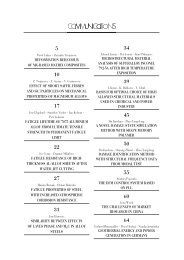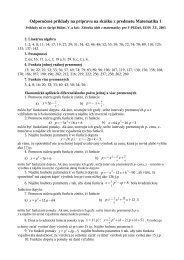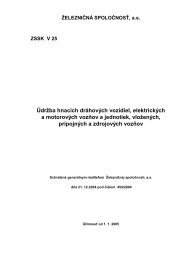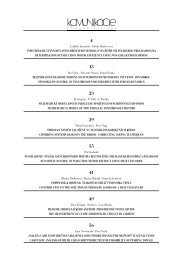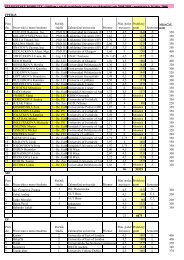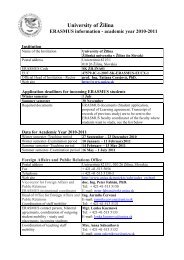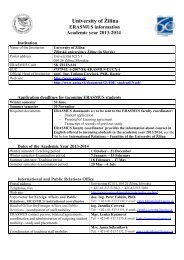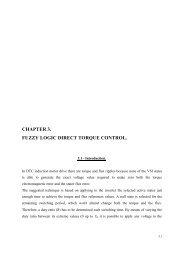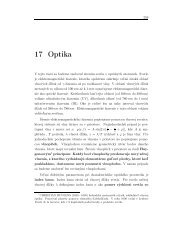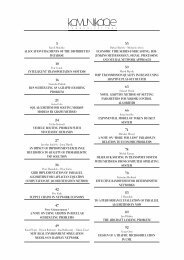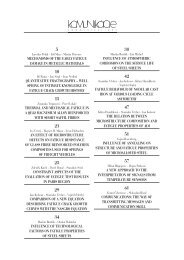Juraj Gerlici – Tomas Lack *MODIFIED HHT METHOD USAGE FOR VEHICLEVIBRATION ANALYSIS IN TIME DOMAINThe paper deals with <strong>the</strong> analysis <strong>of</strong> <strong>vehicle</strong> vibr<strong>at</strong>ions in <strong>the</strong> time domain. The main aim is to modify <strong>the</strong> HHT-method for <strong>the</strong> solution<strong>of</strong> mechanical systems with nonlinear members. The modific<strong>at</strong>ion enables <strong>the</strong> comput<strong>at</strong>ion with <strong>the</strong> constant system comput<strong>at</strong>ional m<strong>at</strong>rix.This causes th<strong>at</strong> <strong>the</strong> triangul<strong>at</strong>ion is to be performed once only and <strong>the</strong> nonlinear members affect only <strong>the</strong> right side <strong>of</strong> <strong>the</strong> algebraic equ<strong>at</strong>ionssystem. This can dram<strong>at</strong>ically decrease <strong>the</strong> time consumption <strong>of</strong> <strong>the</strong> comput<strong>at</strong>ion. We used <strong>the</strong> method modified in this way for <strong>the</strong>dynamic analysis <strong>of</strong> <strong>the</strong> model with <strong>the</strong> parameters <strong>of</strong> <strong>the</strong> specimen “ERRI – <strong>vehicle</strong>” th<strong>at</strong> was kinem<strong>at</strong>ically excited.Key words: vibr<strong>at</strong>ion analysis, time domain, modified HHT-method1. IntroductionThe analysis <strong>of</strong> mechanical systems (for example mechanicalsystems <strong>of</strong> <strong>vehicle</strong>s) vibr<strong>at</strong>ion is permanently very topical. The<strong>vehicle</strong> dynamic properties are determined with <strong>the</strong> help <strong>of</strong> thisanalysis during a new <strong>vehicle</strong> design, or a renewal <strong>of</strong> an older existing<strong>vehicle</strong>. The Eigen frequencies are characteristic <strong>of</strong> a <strong>vehicle</strong>construction. A <strong>vehicle</strong> mechanical system is excited with varioustypes <strong>of</strong> loads in <strong>the</strong> oper<strong>at</strong>ion and this is <strong>the</strong> reason why its individualparts oscill<strong>at</strong>e. The aim <strong>of</strong> a dynamical analysis is not onlyto judge <strong>the</strong> influence <strong>of</strong> an excit<strong>at</strong>ion on <strong>the</strong> mechanical systembut also, on <strong>the</strong> base <strong>of</strong> th<strong>at</strong> analysis, to propose and to performconstruction changes <strong>of</strong> a <strong>vehicle</strong> for <strong>the</strong> detected neg<strong>at</strong>ive st<strong>at</strong>eelimin<strong>at</strong>ion or improvement.3. Methods for vibr<strong>at</strong>ion analysis in <strong>the</strong> time domainThe direct numerical integr<strong>at</strong>ion <strong>of</strong> <strong>the</strong> equ<strong>at</strong>ion <strong>of</strong> motion iswidely used for <strong>the</strong> linear systems solutions where <strong>the</strong> individualprocess character monitoring is important. The principal idea <strong>of</strong>a numerical integr<strong>at</strong>ion lies in <strong>the</strong> fact th<strong>at</strong> we will fulfil <strong>the</strong> equ<strong>at</strong>ion<strong>of</strong> motion in <strong>the</strong> finite t 0 , t 1 , …, t m <strong>moment</strong>s. The distance <strong>of</strong>individual <strong>moment</strong>s is Δt k t k 1 t k , where k 0, 1, …, m1,is labeled a length <strong>of</strong> integr<strong>at</strong>ion step. Starting conditions are aninseparable part <strong>of</strong> an equ<strong>at</strong>ion <strong>of</strong> motion. We consider <strong>the</strong> startto be <strong>the</strong> time t 0. Then it holds:q^h=0 q0qo^h=qo. (1)0 02. Vehicle vibr<strong>at</strong>ion analysisThe aim <strong>of</strong> <strong>the</strong> <strong>vehicle</strong> vibr<strong>at</strong>ion analysis may be <strong>the</strong> <strong>vehicle</strong>behaviour prediction before a performance <strong>of</strong> experimental testsfor a <strong>vehicle</strong> approving into <strong>the</strong> oper<strong>at</strong>ion and saving <strong>the</strong> time andfinancial expenses th<strong>at</strong> may arise according to <strong>the</strong> tests repetition,in <strong>the</strong> case when previous tests had failed. The vibr<strong>at</strong>ion analysiswith <strong>the</strong> help <strong>of</strong> comput<strong>at</strong>ions allows <strong>simul<strong>at</strong>ion</strong> <strong>of</strong> extreme loadingsth<strong>at</strong> evoke critical st<strong>at</strong>es without m<strong>at</strong>erial losses, neg<strong>at</strong>iveinfluence <strong>of</strong> a <strong>vehicle</strong> on <strong>the</strong> track, environment and so on. Thesecomput<strong>at</strong>ions are in practice <strong>of</strong>ten executed with commercial accessibleprogramme packages. They provide results <strong>of</strong> analysis on <strong>the</strong>base <strong>of</strong> chosen <strong>vehicle</strong> parameters, track parameters and loads.The programmes utilise various methods which are <strong>the</strong>ir internalcomponents. It has not become usual th<strong>at</strong> a common user canaffect <strong>the</strong>m.We distinguish <strong>the</strong> three types <strong>of</strong> direct integr<strong>at</strong>ion numericalmethods:– explicit,– implicit,– predictor – corrector.We consider <strong>the</strong> first two types to be <strong>the</strong> fundamental ones.The Predictor – corrector method is in fact a <strong>simul<strong>at</strong>ion</strong> <strong>of</strong> <strong>the</strong>implicit method and is suitable for nonlinear systems solutions.The Integr<strong>at</strong>ion method may be explicit or implicit in dependenceon <strong>the</strong> <strong>moment</strong> in which it uses <strong>the</strong> equ<strong>at</strong>ion <strong>of</strong> movement.We compute <strong>the</strong> qt+ Dt, qot+ Dt,qpt+Dtvectors from <strong>the</strong> equ<strong>at</strong>ion<strong>of</strong> motion with <strong>the</strong> help <strong>of</strong> an explicit method on <strong>the</strong> base <strong>of</strong> <strong>the</strong>q, qq o,p moving characteristics course shape presupposition in <strong>the</strong>interval and <strong>the</strong>ir knowledge in <strong>the</strong> time <strong>moment</strong> t.* Juraj Gerlici, Tomas LackFaculty <strong>of</strong> Mechanical Engineering, University <strong>of</strong> Zilina, Slovakia, E-mail: juraj.gerlici@fstroj.uniza.sk.26 ● COMMUNICATIONS 3/2008
The implicit methods, vice versa, use <strong>the</strong> equ<strong>at</strong>ion <strong>of</strong> motionin <strong>the</strong> time t Δt. They are suitable, first <strong>of</strong> all, for <strong>the</strong> solution<strong>of</strong> <strong>the</strong> linear equ<strong>at</strong>ion <strong>of</strong> motion with a consistent mass m<strong>at</strong>rix.The stability is a characteristic fe<strong>at</strong>ure <strong>of</strong> numerical methods fora direct integr<strong>at</strong>ion <strong>of</strong> an equ<strong>at</strong>ion <strong>of</strong> motion. The stability meansth<strong>at</strong> <strong>the</strong> solutions must not go through limits for <strong>the</strong> arbitrarystarting conditions. If this condition <strong>of</strong> an arbitrary r<strong>at</strong>io <strong>of</strong> Δt/T nis fulfiled, we describe <strong>the</strong> method as unconditionally stable andif it is fulfiled for an individual critical r<strong>at</strong>io Δt/T n only, we talkabout an conditionally stable method. In <strong>the</strong> following text we willapply some methods th<strong>at</strong> may be used for <strong>the</strong> mechanical systemvibr<strong>at</strong>ion analysis in <strong>the</strong> time domain. They are: <strong>the</strong> Differencemethod, <strong>the</strong> Linear acceler<strong>at</strong>ion method, <strong>the</strong> Wilson θ – method,<strong>the</strong> Newmark method [3], and <strong>the</strong> HHT-method [3, 6].Its advantage is <strong>the</strong> possibility to use it for a nonlinear taskssolution as well.3.2 The method <strong>of</strong> linear acceler<strong>at</strong>ionThis method is based on <strong>the</strong> presupposition <strong>of</strong> a linear acceler<strong>at</strong>ioncourse during each <strong>of</strong> integr<strong>at</strong>ion steps, as shown in Fig.1.3.1 The differential methodFor <strong>the</strong> numerical integr<strong>at</strong>ion <strong>of</strong> <strong>the</strong> equ<strong>at</strong>ion <strong>of</strong> motion wesubstitute <strong>the</strong> time invariant variable for differenties. The simpliestdifferential substitutions <strong>of</strong> <strong>the</strong> acceler<strong>at</strong>ions vector qp and <strong>the</strong>velocities vector qo in <strong>the</strong> time t are:1qo = $ _ qt + D t-qt -Dti, (2)2 $ Dt1qp = , (3)t$ _ q 2 $ q q2 t+ Dt- t+t-DtiDth<strong>at</strong> we apply to <strong>the</strong> equ<strong>at</strong>ion <strong>of</strong> motion in <strong>the</strong> time tM$ qp+ B$ qo+ K$q = F . (4)t t t tAfter insertion and modific<strong>at</strong>ion we obtain:1 1 2d $ M + $ Bn$ q F K M q2 t+Dt = t-d- $ n$t-2Dt2 $ DtDt(5)1 1-d$ M - $ Bn$ qtt.2+ DDt2 $ DtThe differential method is <strong>the</strong> type <strong>of</strong> an explicit method. Themethod has all <strong>the</strong> advantages <strong>of</strong> explicit methods, if <strong>the</strong> dampingm<strong>at</strong>rix is B 0 or B α ⋅ M. The most effective usage is in <strong>the</strong>case <strong>of</strong> a diagonal mass m<strong>at</strong>rix, id est for solutions <strong>of</strong> systems withconcentr<strong>at</strong>ed massess. The method is only conditionally stable, inthis case <strong>the</strong> lenght <strong>of</strong> integr<strong>at</strong>ion step Δt has to meet <strong>the</strong> followingdemand:T nDt# , (6)rwhere T n is <strong>the</strong> smallest period <strong>of</strong> <strong>the</strong> vibr<strong>at</strong>ion. The rel<strong>at</strong>ively veryshort length <strong>of</strong> integr<strong>at</strong>ion step is needed in order to ensure th<strong>at</strong><strong>the</strong> difference method gives <strong>the</strong> correct solution. Ano<strong>the</strong>r disadvantageis <strong>the</strong> fact, th<strong>at</strong> we need to use <strong>the</strong> special procedure in<strong>the</strong> first step.2Dtq- Dt = q0- Dt$ qo0+$ qp02(7)Fig. 1 An acceler<strong>at</strong>ion courseWe label <strong>the</strong> variable th<strong>at</strong> changes in <strong>the</strong> interval with<strong>the</strong> mark τ, we express <strong>the</strong> rel<strong>at</strong>ion for acceler<strong>at</strong>ion with:xqt p^+ xh= qp t q qt+ _ pt +D t-ptiD(8)We obtain <strong>the</strong> rel<strong>at</strong>ions for qt o ^ + xh and qt ^ + xhvia <strong>the</strong>double integr<strong>at</strong>ion:2xqt o^+ xh= x$qp + _t q p q q2+D - pi+ o$ Dt t t. (9)2 3x xqt ^ + xh= $ qp 2 6 t q q q qt+ _ pt+Dt- pti+ x $ ot+t$ DIn <strong>the</strong> end <strong>the</strong> integr<strong>at</strong>ion step for x = Dt we will get:Dt Dt qot+ Dt = Dt$qpt+ _ q pt+ Dt- q pti+ q ot = q ot+ _ q pt+Dt+q pti2 22 2Dt Dtqt+ Dt = q pt+ _ qpt+Dt- qpti+ Dt$qot+ qt=2 62Dt= qt+ Dt$ qot+ _ qpt+Dt+2 $ qpti6(10)From <strong>the</strong>se rel<strong>at</strong>ions we obtain <strong>the</strong> rel<strong>at</strong>ions for qp t+Dta qot+Dt6qpt+ Dt = _ q t q q 2 q2 t+Dt-D$ ot- ti- $ ptDt3q qt q t q q t q Dt ot+ Dt = ot+ _ t+Dt-D$ ot- ti- D $ pt+ q pt=D233 Dt = $ qt+Dt-2$ qot- $ qt-q p(11)tDtDt2COMMUNICATIONS 3/2008 ●27
- Page 5 and 6: Mt = k$ Di(12) 4. Torsion moment at
- Page 7: References[1] JOVANOVIC, R.: Tensio
- Page 10 and 11: Fig. 3 Geometrical parameters of ch
- Page 12 and 13: Fig. 13 10. eigenvector when the ei
- Page 14 and 15: and D R _ y,wi=0 if y 0 (12) Dampe
- Page 16 and 17: Fig. 22 Comfort for passengers for
- Page 18 and 19: 3. Intermodal trainsIntermodal trai
- Page 20 and 21: Fig. 2 Consignment reloading proces
- Page 22 and 23: attached to individual tracks shown
- Page 26 and 27: After the insertion of the previous
- Page 28 and 29: where:k - is the basic spring stiff
- Page 30 and 31: [2] GERLICI, J., LACK, T.: Methods
- Page 32 and 33: Resulting from experience the degre
- Page 34 and 35: Upon this strengthening of pretensi
- Page 36 and 37: attained the 6th position of the be
- Page 38 and 39: Jozef Jandacka - Stefan Papucik - V
- Page 40 and 41: spacing of the fan from the measuri
- Page 42 and 43: 5. ConclusionFrom the results prese
- Page 44 and 45: REVIEWlines with numerous curves th
- Page 46 and 47: REVIEWmeters from the point of view
- Page 48 and 49: REVIEWBojan Cene - Aleksandar Rados
- Page 50: REVIEWthe year 2006 in Slovenia sta
- Page 53 and 54: REVIEWthat the GPS does not recogni
- Page 55 and 56: REVIEWRadomir Brkic - Zivoslav Adam
- Page 57 and 58: REVIEWfailures. For example, for an
- Page 59 and 60: REVIEWJan Krmela *COMPUTATIONAL MOD
- Page 61 and 62: REVIEWFor this reason tyres and whe
- Page 63 and 64: REVIEWFig. 6 Computational model
- Page 65 and 66: REVIEW- guarantee that the messages
- Page 67 and 68: REVIEWIvana Olivkova *PASSENGER INF
- Page 69 and 70: REVIEWLike the other information sy
- Page 71 and 72: REVIEWFig. 1 Revolution of the poin
- Page 73 and 74: REVIEWFig. 4 Transformation of the
- Page 75 and 76:
BOOK REVIEWKavicka, A., Klima, V.,



